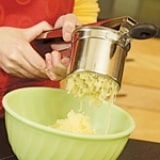This classic Italian dish is a simple-to-make crowd-pleaser. A cross between pasta and dumplings, potato gnocchi are a scrumptious switch from your everyday spaghetti. You can bake these tender, fluffy pillows in our rich, cheesy sauce, or try one of our serving suggestions. Though making gnocchi from scratch may seem daunting, the most difficult thing about gnocchi is saying the word (it's pronounced NYOH-kee). Kids get to help by playing with - er, shaping - the dough.
Ingredients
FOR THE GNOCCHI:
- 1 pound (about 3 medium) gold-fleshed potatoes, such as Yukon Gold
- 1 teaspoon salt
- 1/4 teaspoon ground black pepper
- 1 tablespoon finely grated Parmesan
- 1 large egg, lightly beaten
- 1/2 cup plus 1 to 2 tablespoons (or more) flour
FOR THE SAUCE:
- 1/3 cup finely grated Parmesan
- 1/2 cup heavy cream
Instructions
1. Scrub the potatoes and place them in a large pot. Cover the potatoes with a couple of inches of water, add ½ teaspoon salt, then boil the potatoes gently until they're cooked through, about 30 to 35 minutes. (Check to see if they're done by poking them with a fork or a skewer.) Transfer the potatoes to a plate and let them cool, about 20 minutes.
2. Meanwhile, lightly butter a medium-size casserole and set it aside. Put a large, fresh pot of water on high heat, and heat the oven to 400 degrees.
3. Peel the potatoes and, working over a large bowl, put them through a potato ricer. If you don't have a ricer, force the potato flesh through a sieve with the back of a large spoon. (A regular masher won't give you the texture you need for light, fluffy gnocchi.)
4. Add the remaining ½ teaspoon salt, the pepper, the Parmesan, and the egg to the riced potatoes. Toss gently to mix. Add the 1/2 cup flour and stir well to make a moist dough. Stir in another tablespoon or two of flour, as necessary, to make the dough just firm enough to knead. Turn the dough out onto a floured counter and knead very gently for 1 minute with floured hands. Add a little extra flour to the counter, if necessary, so that the dough doesn't stick.
5. Divide the dough into four pieces. Working with one piece at a time, roll the dough into a rope about ¾ inch thick and 18 inches long. Using a knife or a dough scraper, cut the rope into 3/4-inch-long pieces.
6. Press the tines of a fork into one side of each piece, just deep enough to leave a mark. Transfer the pieces to a floured plate. Each rope makes about 20 gnocchi.
7. After you've cut and shaped the gnocchi, gently drop about half of them into the lightly boiling water. After 1 to 2 minutes the gnocchi should rise to the surface. Once they do, cook them at a low boil for another 1 1/2 minutes. Be careful: a vigorous boil may cause the gnocchi to fall apart. Remove the gnocchi with a small strainer, let them drip dry for several seconds, then place them into the buttered baking dish. Cook the remaining gnocchi and add them to the dish as well.
8. You can use cooked gnocchi in any number of ways (see "Serving Suggestions," below, for a few ideas). For a simple, creamy sauce, sprinkle the gnocchi with 1/3 cup Parmesan and drizzle the heavy cream over the top. Bake the dish on the center oven rack until the sauce is bubbly, about 10 to 12 minutes. Serve at once. Makes about 5 servings.
Tips: Serving Suggestions
Cook the gnocchi in chicken broth to make a simple dumpling soup. Garnish each serving with a pinch or two of minced scallions. Saute cabbage or other greens. Just before the greens are done, add cooked gnocchi and a handful of diced, cooked kielbasa or other sausage to the pan. Saute them together until everything is hot and the greens are fully cooked. Stir cooked gnocchi into leftover ratatouille or another saucy stew. Gently mix cooked gnocchi with Alfredo sauce, marinara sauce, or pesto. Spoon the mixture into a pan, sprinkle with Parmesan, and bake it as directed in the main recipe.
Nutritional Information:
Per serving (15 pieces), with cheese sauce: Calories 211, Protein 6 g (13% DV), Carbohydrate 24 g (8% DV), Total Fat 10 g (15% DV), Cholesterol 67 mg (22% DV), Saturated Fat 6 g (29% DV), Sodium 300 mg (12% DV), Fiber 2 g (6% DV), Sugars 1 g, Vitamin C (24% DV), Iodine (22% DV)
Percent daily values are based on a 2,000-calorie diet. Your daily values may be higher or lower depending on your calorie needs.
Food , Recipes












